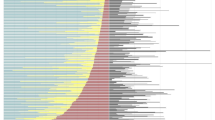Summary
Leptothorax unifasciatus workers differentiate new areas from those previously explored. Indeed, a “coming and going” behaviour appears more frequent on a virgin paper than on a familiar one. The decrease of activity on a new paper after some hours indicates that this species rapidly gets to known such an area in the experimental device used here. The experiments suggest that the area is chemically modified by the ants' activity, but the possibility of a specific marking behaviour was not further investigated.
Three factors control the level of foraging activity inL. unifasciatus:
-
1o.
The nature of the foraging area (familiar or virgin).
-
2o.
The size of the society.
-
3o.
The age of the nest-site.
Societies newly established in their nest show a higher level of foraging activity on a virgin area than on a familiar one. In every case, there is a linear relation between the size of the society and its activity. Long-settled societies always show a lower activity than recently established ones, and no difference was observed when they recruited on a virgin and a familiar area. Moreover, the society size appears to be less important in determining the general level of activity than for recently-settled societies.
These results are tentatively interpreted in eco-ethological terms, taking into account a main biological characteristic ofLeptothorax societies: frequent nest emigrations that are either seasonal or due to fragile nest-sites.
Resume
Les ouvrières deLeptothorax unifasciatus différencient de nouvelles aires de celles précédemment explorées. En effet, un comportement de «va-et-vient» apparaît plus fréquent sur un papier vierge que sur un papier familier à la colonie. La chute d'activité sur un papier vierge après quelques heures indique que ce dernier devient rapidement familier à la colonie dans le dispositif expérimental utilisé. Les expériences suggèrent que le territoire est modifié chimiquement par l'activité des fourmis, mais la possibilité d'un marquage chimique n'a toutefois pas été explorée.
Trois facteurs contrôlent le niveau d'activité de fourragement chezL. unifasciatus:
-
1o
la nature de l'aire de récolte (connue ou inconnue);
-
2o
la taille de la société;
-
3o
le temps de séjour de la société dans un même nid.
Des sociétés établies récemment dans leur nid montrent un niveau d'activité de fourragement plus élevé sur une aire de récolte inconnue que sur une aire familière. Dans tous les cas, il existe une relation linéaire liant la taille de la société et son activité. Des sociétés établies depuis longtemps dans un même nid montrent toujours une activité inférieure aux sociétés récemment établies. Aucune différence n'est observée entre une aire de récolte inconnue et familière. De plus, la taille de la société apparaît être moins influente sur son activité générale que pour une société récemment établie dans son nid. Ces résultats sont interprétés en termes éco-éthologiques, tenant compte d'une caractéristique biologique essentielle des sociétés deL. unifasciatus: les déménagements fréquents, saisonniers ou liés à la précarité des nids.
Similar content being viewed by others
References
Alloway T.M., 1980. — The origins of slavery inLepthoracine ants (Hymenoptera: Formicidae).Am. Natural., 115, 247–261.
Buschinger A., Ehrhardt W., Winter U., 1980. — The organization of slave raids in dulotic ants. A comparative study (Hymenoptera; Formicidae).Z. Tierpsychol., 58, 245–264.
De Geyter A., 1982. — Le recrutement alimentaire chezLepthothorax unifasciatus (Hym. Formicidae). Etude comportementale et dynamique.Mémoire de licence. Université Libre de Bruxelles, 83 pp.
Deneubourg J.L., Pasteels J.M., Verhaeghe J.C., 1983. — Probabilistic behaviour in ants: A strategy of errors?J. Theor. Biol., 105, 259–271.
Du Merle P., Jourdheuil P., Marro J.P., Mazet R., 1978. — Evolution saisonnière de la myrmécofaune et de son activité prédatrice dans un milieu forestier.Ann. Soc. Ent. France, 14, 141–157.
Jaffé K., Bazire-Benazet M., Howse P.E., 1979. — An integumentary pheromone secreting gland inAtta sp.: territorial marking with a colony-specific pheromone inAtta cephalotes.J. Ins. Physiol., 25, 833–839.
Lane A., 1977. — Recrutement et orientation chez la fourmiLeptothorax unifasciatus (Latr.): Rôle de la piste et des tandems.Thèse de 3e cycle, Dijon, 124 pp.
Möglich M., 1978. — Social organization of nest emigration inLeptothorax (Hym., Form.).Ins. Soc., 25, 205–225.
Pasteels J.M., Verhaeghe J.C., Deneubourg J.L., 1982. — The adaptative value of probabilistic behaviour during food recruitment in ants: Experimental and theoretical approach. In:Biology of Social Insects, M.D. Breed, C.D. Michener, H.E. Evans ed., Westview Press, Boulder, 297–301.
Plateaux L., 1970. — Sur le polymorphisme social de la fourmiL. nylanderi (Förster). I. Morphologie et biologie comparées des castes.Ann. Sci. nat., Zool. Biol. animale, 12, 4, 373–478.
Rohlf F.J., Sokal R.R., 1981. —Statistical tables. W.H. Freeman and Company, England, 219 pp.
Roisin Y., 1982. — Eco-éthologie de l'approvisionnement du nid chez lesTetramorium belges (Hym. Formicidae).Mémoire de licence, Université Libre de Bruxelles, 79 pp.
Siegel S., 1956. —Non-parametric Statistics for the Behavioral Sciences. Mc. Graw-Hill, New York, pp. 312.
Stuart R.J., Alloway T.M., 1982. — Territoriality and the origin of slave raiding inLeptothoracine ants.Science, 215, 1262–1263.
Stuart R.J., Alloway T.M., 1983. — The slave-making ant,Harpagoxenus canadensis M.R. Smith and its host-species,Leptothorax muscorum (Nylander): slave raiding and territoriality.Behaviour, 85 (1–2), 58–90.
Author information
Authors and Affiliations
Rights and permissions
About this article
Cite this article
Aron, S., Pasteels, J.M., Deneubourg, J.L. et al. Foraging recruitment inLeptothorax unifasciatus: The influence of foraging area familiarity and the age of the nest-site. Ins. Soc 33, 338–351 (1986). https://doi.org/10.1007/BF02224249
Received:
Accepted:
Issue Date:
DOI: https://doi.org/10.1007/BF02224249




